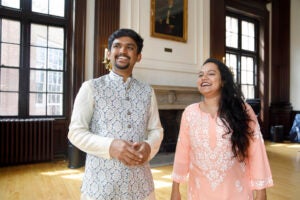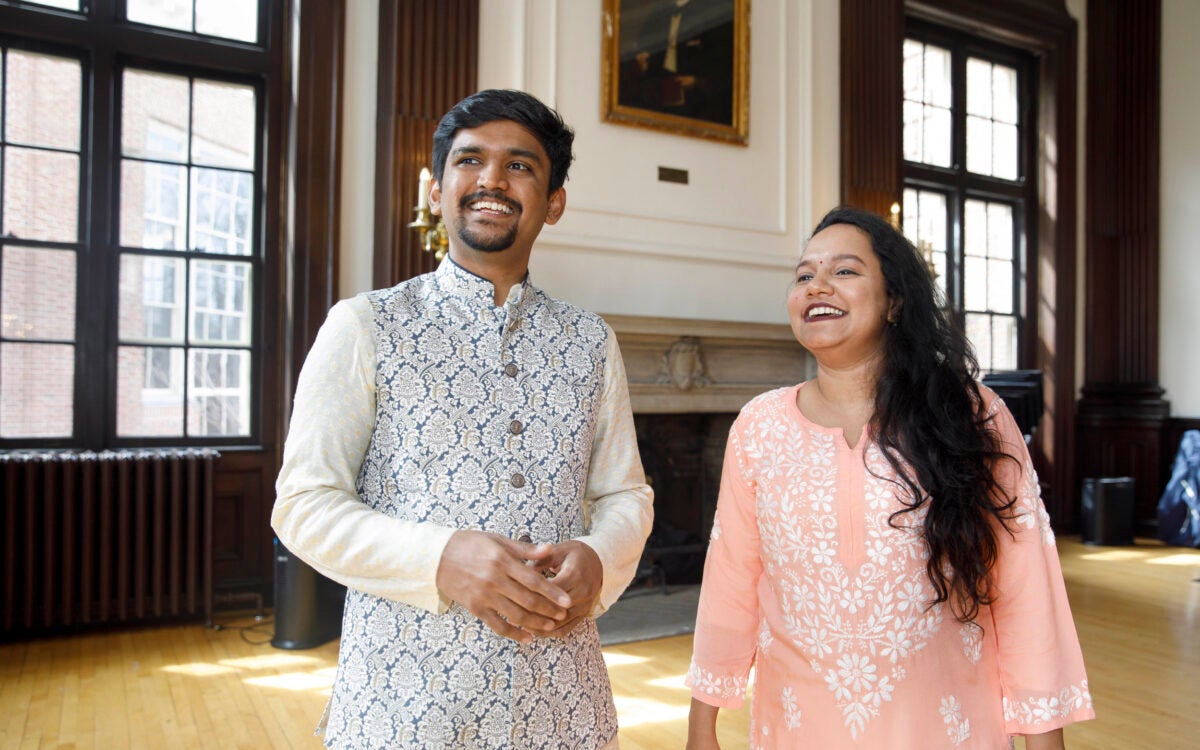Seeing through others’ eyes
Walton discusses College’s approaches to diversity, makes recommendations, and reaffirms priorities to foster culture of inclusion
Danoff Dean of Harvard College Rakesh Khurana issued the final report of the Working Group on Diversity and Inclusion this week. The report details recommendations for how Harvard’s increasingly diverse student body can better be supported to ensure that every student benefits equally from the School’s liberal arts and sciences educational and service-oriented mission.
The working group was created last year by Khurana and Donald Pfister, then interim dean of the College, was chaired by Jonathan L. Walton, Plummer Professor of Christian Morals, and included College students and faculty from a range of backgrounds. In a statement about the importance of diversity and inclusion, both on campus and in society, Harvard President Drew Faust committed to creating a University-wide effort to address questions that go beyond the working group’s mandate.
The Gazette recently sat down with Walton, who also serves as Pusey Minister in the Memorial Church, to talk about the key themes of the report, the College’s commitment to further exploration of innovative approaches to diversity, and recommendations for creating a more inclusive campus culture.
GAZETTE: What was the charge of this working group? What were your priorities during your evaluation?
WALTON: Our group believes this would help the Houses move beyond living and social spaces and become spaces of personal transformation, which is really an intentional pedagogical goal of the House system here at Harvard. Our priority was to examine the many offices at Harvard College that are tasked with matters of diversity on our campus, to consider best practices, possible blind spots, and possibilities that we might want to consider moving forward.
GAZETTE: Where did the working group focus the majority of its research?
WALTON: While we focused the bulk of our research on student life at the College, of course, one cannot discuss student life without considering the many aspects of the institutional context, which includes faculty, departmental cultures, and the University administration. We also spent a considerable amount of time researching our peer institutions. The working group wanted to learn from other institutions, as we are aware that fostering cultures of belonging and excellence through diversity are among the top priorities throughout the Ivy League.
GAZETTE: What are the major highlights of the working group’s final report?
WALTON: I think the biggest takeaway is that in thinking about matters of diversity and cultures of belonging on campus, this work not be divorced from other research efforts that are taking place such as sexual assault prevention and ways to effectively support first-generation students. At the end of the day this is about affirming the inherent dignity of all distinct populations at Harvard University. For me, this is one of the reasons that while our efforts were preliminary, we are now calling for our questions and areas of concern to be expanded to the University level.
That ties in well with what I think is the major finding of this report, and that is we cannot have a healthy diverse environment without coordination across all departments, Schools, administrative offices, and allies across the University. We also discovered how easy it is for an institution to fall prey to the status quo. This is why we have to be so intentional and coordinated in our efforts.
GAZETTE: You mention the working group spent time researching best practices. What are those best practices, and is there one specific model for this work that is best?
WALTON: We learned that every campus is unique in [its] approach. Campuses must attend to their particular histories, geographic setting, and community constitution, among other things. While there is no one model or best practice that will work for all, our findings do reveal that fostering healthy diverse cultures of belonging is a multidimensional effort that necessitates buy-in from every division of an institution.
Moreover, students have expressed [that] they appreciate ongoing face-to-face engagement. And this is particularly true for more vulnerable populations such as first-generation students who may not have unofficial networks of support to rely on. The best support systems meet students on the campus where they are.
GAZETTE: Let’s talk about the current state of diversity and inclusion on Harvard’s campus. What are we doing now and what more can be done?
WALTON: One of the things that we identified on campus is what we labeled an “ideology of the informal,” meaning that while House masters and administrators are committed to creating communities of diverse interactions where students can learn about one another across the sliding categories of difference, many students feel that informal interactions are insufficient for their needs.
We know that Community Conversations is a great resource. An overwhelming 70 percent of seniors of one graduating class felt strongly that Community Conversations helped them to appreciate Harvard’s diversity. But it only meets when students arrive on campus as freshmen, and many students felt [that] there should be sustained dialogue and follow-up throughout one’s academic career. Having periodic events like this for structured conversations on diversity matters would be invaluable, particularly when led by dedicated and trained facilitators who can help promote a common language of engagement.
GAZETTE: What recommendations are you making to the College to address the challenges associated with learning and living in a diverse residential community?
WALTON: The House system plays a powerful co-curricular role at Harvard. For one, we would like to see each House and the freshmen deans design and implement a cohesive series of formal co-curricular activities that speak to the challenges and benefits of living and learning in a diverse residential community. Such activities might include retreats, special Wintersession events, spring break excursions, or service-learning projects. Our group believes this would help the Houses move beyond learning and personal transformation as an inevitable outgrowth of living in a diverse environment to an intentional pedagogical goal of the Houses.
GAZETTE: Let’s discuss the group’s recommendations for immediate action. Where can the College focus to have the most impact?
WALTON: For one, we recommend ongoing cultural competency training for all College student-facing staff members. This should include personnel in the Office of Student Life, Freshman Dean’s Office, and Administrative Board, for example.
The working group also recommends that the College diversify the Administrative Board and the new Honor Council. There is a reasonable concern that without faculty of color or faculty who may themselves be first-generation students, these boards are missing crucial sets of experiences and nuanced interpretations that could lead to fairer judgments and penalties.
GAZETTE: What about the initiatives that the College is already undertaking?
WALTON: Our group engaged in conversation with the dean of the College throughout the last academic year, and the College was able to pilot and implement a few recommendations along the way. For instance, the working group raised a concern about unnecessary markers of social distinction. In turn, the College eliminated the special Student Events Fund (SEF) ticket line that singled out students who qualify for financial aid. Similarly, keeping two dining halls open during spring break helped to alleviate some of the economic pressures with which many students expressed frustration.
We must also recognize Paul Barreira and Kathy Lapierre of Harvard University Health Services. Last year the working group entered conversations with the leadership of the Steve Fund to ensure mental health support for students throughout the campus, while addressing particular cultural needs and associated stigmas of specific minoritized groups. Several small gatherings and panels have taken place over the past year to address mental health among Asian Americans, Latinx, and African-Americans on campus. Our hope is that this will lead to a comprehensive and strategic outreach plan at Harvard for historically underserved populations.
GAZETTE: Your group makes multiple recommendations in the area of teaching and learning. What are the most important areas for Harvard College to consider?
WALTON: We are recommending that the College task the directors of undergraduate studies in each department to develop clear pathways through the concentrations that are attainable for all students. Just because a student attended a high school without a surfeit of AP [advanced placement] classes, that student should not be excluded from particular concentrations the moment they arrive on campus. Every student deserves a chance to succeed in the concentration of their choice, even if they need to begin from the most introductory-level course.
GAZETTE: We discussed earlier the College’s priorities for fostering a more diverse and inclusive environment for students to thrive, and I wanted to follow up on that and ask whether that work is creating a difference at all?
WALTON: The fact that we are having this conversation is a testament to the fact that the College’s work is making a difference. I can speak for the other faculty and administrators on the working group and say that one of the greatest joys of our efforts was meeting a range of amazing students throughout this College from all different walks of life. Each contributed to our work their own particular form of genius and wisdom.
GAZETTE: What does all this say about the future of Harvard College?
WALTON: It says that the future is in our hands. I heard President Faust say one time that “Veritas is not value neutral.” We have the opportunity to shape Harvard into the sort of institution we want it to be. It is rewarding to feel that the president desires for us to be an institution that is both shaped and strengthened by the beauty of its diversity.




